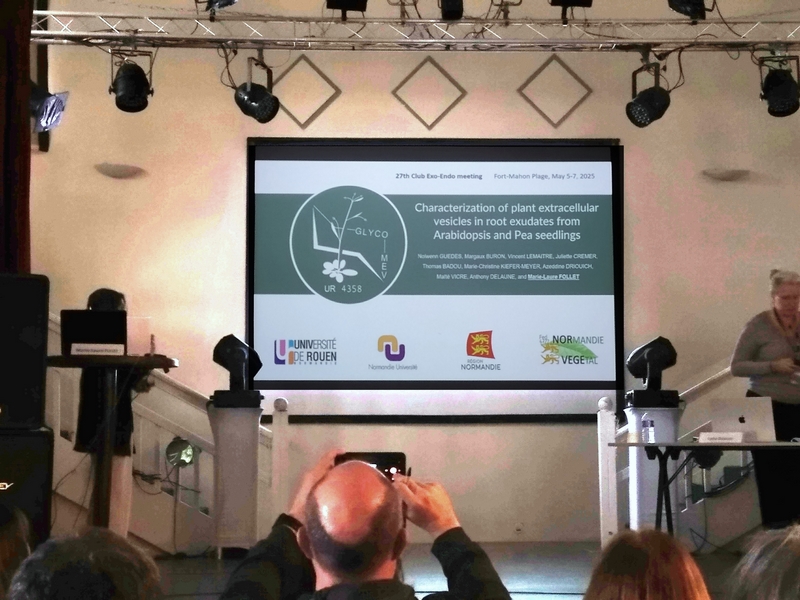Club Exo-Endo 2025
27ème Congrès
Du 5 au 7 mai 2025 s'est tenu le 27ème congrès du Club Exocytose-Endocytose à Fort-Mahon (Baie de Somme). Cette association à but non lucratif, sans financement ni cotisation, rassemble depuis plus de 20 ans près de 340 chercheurs, enseignants ou étudiants travaillant dans des domaines variés de la biologie cellulaire et moléculaire, dont le trafic intracellulaire, la dynamique des membranes et la microscopie.
Au cours de ces trois d'échanges scientifiques denses, le Dr Marie-Laure FOLLET, représentait le Laboratoire GlycoMEV et a exposé les travaux de l'équipe lors d'une conférence intitulée :
« Characterization of plant extracellular vesicles in root exudates from Arabidopsis and Pea seedlings. »
Guedes N, Buron M, Lemaitre V, Cremer J, Badou T, Kiefer-Meyer MC, Driouich A, Vicré M, Delaune A, Follet ML
Résumé :
Plants are sessile organisms that must adapt to their environmental conditions. There is currently a growing interest into the functional role of the so-called unconventional protein secretion (UPS) processes in these adaptations. While conventional protein secretion (CPS) is known to involve the ER-Golgi-TGN continuum, UPS is characterized by bypassing Golgi stacks. During this process, antimicrobial proteins and cell wall polymer remodeling enzymes can be secreted into the extracellular space. The UPS could provide a rapid way for modulating both barrier and signaling properties of plant cell walls. While the involvement of this alternative mechanism of secretion, in particular via the production of extracellular vesicles (EVs), is described during the perception of stress and/or elicitation in the aerial part of the plant, its contribution to root immunity is poorly documented.
We are currently characterizing the EVs produced by root cells of two plant species, namely Arabidopsis thaliana and Pisum sativum. Using microscopical techniques (Nanoparticle tracking analysis/Transmission electron microscopy), we have been able to identify nanometric vesicular structures ranging from 50 to 150nm in diameter. We have also found that the expression of EV marker genes (e.g., EXO70E2, TET8, and PEN1) is modulated early during infection of pea root by the pathogenic oomycete Aphanomyces euteiches. These promising results open up numerous prospects for fundamental research into secretory processes in relation with root defense.
Funding support :
Région Normandie, RIN émergent EVASion (2022-2024)

Participation de Marie-Laure Follet
![]()





 Adresse : 1er étage Bâtiment CURIB, Place E. Blondel, UFR Sciences et Techniques - Université de Rouen Normandie, F-76821 Mont Saint-Aignan CEDEX France
Adresse : 1er étage Bâtiment CURIB, Place E. Blondel, UFR Sciences et Techniques - Université de Rouen Normandie, F-76821 Mont Saint-Aignan CEDEX France Téléphone Secrétaire administrative : +33 (0)2 35 14 63 56
Téléphone Secrétaire administrative : +33 (0)2 35 14 63 56 E-mail Secrétaire administrative :
E-mail Secrétaire administrative : 

